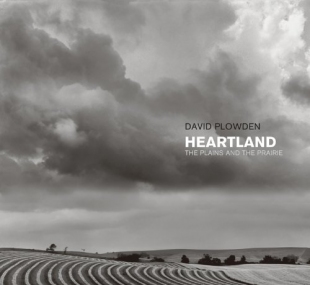Photographer David Plowden loves the landscapes of the Heartland of America — the cornfields of Iowa, the big sky of Nebraska, and the frozen flatlands of the Dakotas.
Here is a celebration of this territory which Newsweek once characterized as "the American Outback." Whereas others tire of the repetitiveness of the Plains, Plowden helps us to slow down and see all the marvels and little wonders in the sameness.
- Taken at sunrise in Funk's Grove, Illinois, a black-and-white photograph conveys the landscape looking as if it were the ocean.
- In another picture, harvested wheat looks like the stripes of the American flag.
- In several photos, angry looking clouds travel quickly over the land which offers no resistance.
Michael Martone in an essay on "The Flatness" has said of the Heartland: "The Midwest landscape is abstract, and our response to the geology of the region might be similar to the contemporary walls of paint in museums. We are forced to live in our eye. We are forced to live in our eyes, in the outposts of our consciousness, the borders of our being. Forget the heart. In the flatness, everywhere is surface. This landscape can never take us emotionally in the way smoky crags or crawling oceans can. We stare back at it. Beneath our skins, we begin to disassemble the mechanisms of how we feel. We begin to feel."
Paging slowly, contemplatively, through this book, we find ourselves seeing and feeling differently about these often familiar objects and places. We linger with them.
- Grain elevators rise like skyscrapers out of the land; housing life-giving nutrients, they are a connection between heaven and earth.
- A freight train stretches across the extended landscape; there is no beginning, no end.
- Abandoned farm houses look lonely in the treeless landscapes; they evoke our compassion.
Dan O'Brien opened his novel In the Center of the Nation with this observation: "When you get the feeling that the whole world can see you but no one is watching, you have come to the grasslands of North America."
- The wind blows fiercely when there is nothing in the way to block it.
- Baled hay reminds us of the farmers who labor so hard to make a living in this open landscape.
- Dryness is always lurking in the Heartland.
William C. Sherman has commented: "Above all, it is a land in serious need of rain."
- The wide-open spaces demonstrate the way the landscape isolates people from each other.
- Small towns show the scars of a boom-and-bust syndrome.
- The Plains seem to beckon us to silence and solitude.
Spiritual writer and South Dakota resident Kathleen Norris has found deep meaning in these rugged places:
"A person is forced inward by the spareness of what is outward and visible in all this land and sky. The beauty of the Plains is like that of an icon; it does not give an inch to sentiment or romance. The flow of the land, with its odd twists and buttes, is like the flow of Gregorian chant that rises and falls beyond melody, beyond reason or human expectation, but perfectly.
"Maybe seeing the Plains is like seeing an icon: what seems stern and almost empty is merely open, a door into some simple and holy state."
We like the idea of viewing the Heartland as an icon, and we are grateful to David Plowden for creating these austere and amazing photographs. He has given us a slice of America that is usually overlooked and underappreciated as cars roar down freeways and planes zip by in the sky between the two coasts.
Settle in for a quiet and meditative time when you can contemplate these icons of the Plains. What do you see? Where do they take you?
